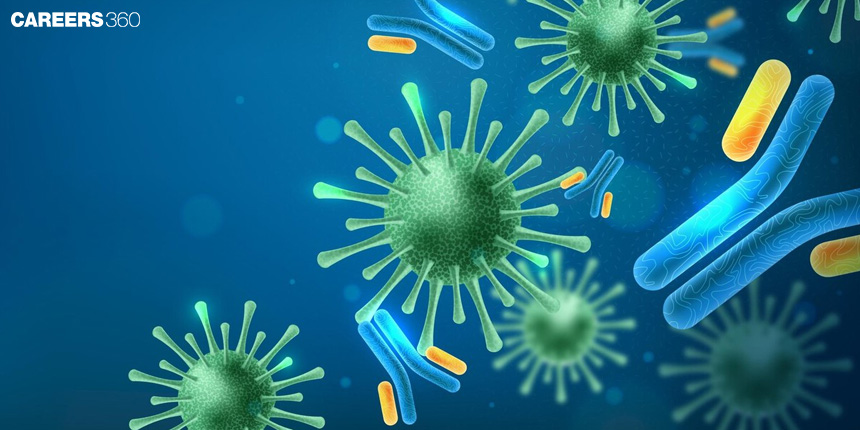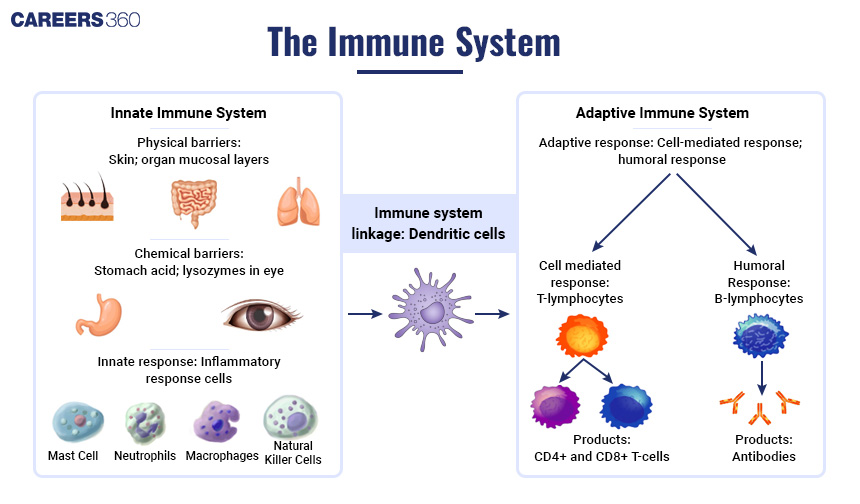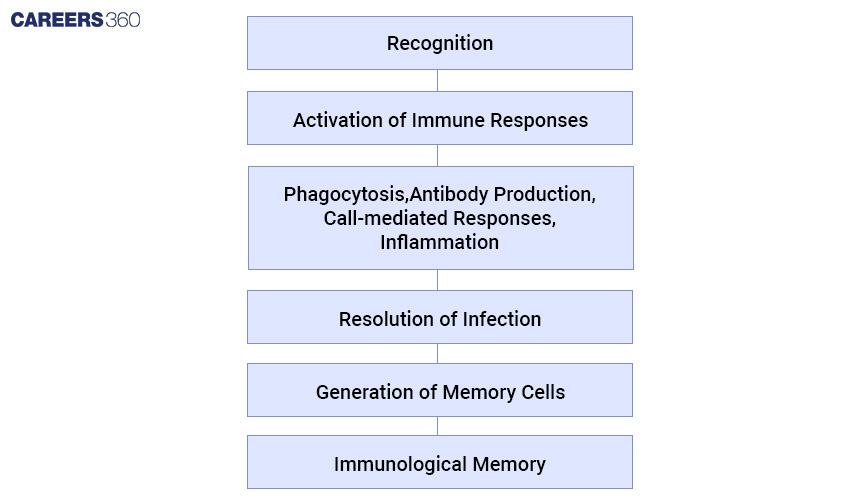Immunology: Meaning, Types, Examples, Treatment, Symptoms
Immunology Definition
Immunology is the branch of medicine that studies the structure and functioning of the immune system; and its mechanisms to defend against viruses, infections, and diseases.
What is Immunology?
Immunology helps us understand how our bodies fight disease and resist it— but nowadays it is one of the basic disciplines in modern-day rapidly evolving medical care. While encompassing many aspects, the subject is still quite alive; this ranges from detailed interactions among immune system molecules or cells to revolutionary therapeutic approaches such as vaccines and immunotherapy. Over the years, the immune system has changed a lot as scientists learn more about it. It consists of a complex network of cells and molecules that work together to protect the body against harmful pathogens. At the same time that we deal with autoimmune reactions from excess resistance or hypersensitivity during immunisation, there are new areas of research opening up with revolutionary technologies such as CRISPR.
NEET 2025: Mock Test Series | Syllabus | High Scoring Topics | PYQs
NEET Important PYQ's Subject wise: Physics | Chemistry | Biology
New: Meet Careers360 B.Tech/NEET Experts in your City | Book your Seat now
- Immunology Definition
- What is Immunology?
- What is the Immune System?
- Types of Immune System
- Innate Immunity
- Adaptive Immunity
- How the Immune System Works
- Vaccines and Immunisation
- Symptoms of Immune Dysfunction
- Immunology Techniques
- Advances in Immunology
- Practical Applications and Careers in Immunology
- Conclusion

What is the Immune System?
The immune system is a complex body defence system that functions to protect the body from infections, disease, and even tumour cells. Immunology, being the study of this complex entity of cells, tissues, and organs, includes how the immune system can recognize and eliminate pathogens while maintaining tolerance to self-components. It plays an important role in developing vaccines, immunotherapies and various strategies to enhance the innate defence mechanisms of the body to fight against autoimmune diseases. Scientific studies uncover the hidden mechanisms of diseases, thereby opening doors to new treatments and interventions to deal with a wide range of health issues.
Types of Immune System
There are two types of immune systems, which are classified based on whether they are present at the time of birth or not:
Innate Immune System.
Adaptive Immune System.
Innate Immunity
Innate immunity, the first level of defence against infectious agents and other foreign substances, is very fast in response and neutralizes potential threats quickly.
The first line of defence includes physical, chemical, and mechanical barriers: the skin, mucous membranes, enzymes, and antimicrobial proteins that actively prevent pathogen entrance.
White blood cells, such as macrophages and neutrophils, are important cellular components of the mechanisms. Innate immunity operates to engulf and subsequently destroy invading foreign substances, in a process called phagocytosis.
Innate immunity provides general protection without any need for prior exposure to or recognition of a pathogen.

Adaptive Immunity
Adaptive immunity is the second line of defence in the body.
This includes specific lymphocytes (B and T cells) with antibodies.
Adaptive immunity uniquely provides reactions towards pathogens.
Adaptive immunity provides immunological memory and, therefore, improvement in resistance to future encounters with the same pathogens.
T cells play central roles in cell-mediated immunity: helper T cells coordinate the immune responses, cytotoxic T cells kill the infected or otherwise damaged cells, and the regulatory T cells fine-tune the overall intensity of the immune response and maintain the immune tolerance.
Also read:
- Human Health And Diseases: Definition, NCERT, MCQs, Questions
- Viral Diseases: Meaning, Types, Causes, Symptoms, Treatment
Table showing the difference between innate immunity and adaptive immunity.
Innate Immunity | Adaptive Immunity |
The response is quick. | The response is slow. |
Not specific in nature. | Highly specific. |
Does not have memory related to immunology. | It has the memory associated with immunology. |
It gives an immediate protection to the body. | It gives long-term protection to the body. |
Key components of this immunity are physical barriers like skin. | Key components of this immunity are antibodies and B and T cells. |
How the Immune System Works
A well-organised and intricate sequence of events occurs in the immune system when pathogens are encountered. Such a response includes recognising them, mounting an effective reaction, and developing immune memory.
Recognition
The immune system contains specific receptors, known as pattern recognition receptors (PRRs). It allows for pathogen detection. They identify specific molecular patterns on their surface, known as pathogen-associated molecular patterns (PAMPs).
Macrophages, dendritic cells, and neutrophils also express PRRs. Furthermore, epithelial cells, along with other tissues, also have these receptors. When PRRs come into contact with pathogens, they trigger immune responses signalling cascades.
Response
Once pathogens enter the body, various means are employed by the immune system to fight them. Phagocytosis is a mechanism by which phagocytic cells, mainly neutrophils and macrophages, engulf and digest pathogens, thereby eliminating them from the body.
In immunity, antibody production occurs via a process of b-cell activation that causes them to change into plasma cells that release antibodies that are unique to a specific pathogen- which can either kill off the pathogens directly by neutralisation, trigger their killing by other immune cells, or else carry them to the lymph nodes for disposal.
Memory
Post-infection, memory B and T cells are produced in the body so that reinfection can be prevented. The memory B cells will keep the ability to produce quickly certain specific antibodies in the case of reinfection, so re-exposure will induce a quick and efficient immune response.
Similarly, upon re-encounter with specific antigens, the reactivity of memory T cells is improved, a development that aids in the quick elimination of pathogens and disease containment.

This flowchart displays the sequential steps implicated in the immune response process from the recognition of pathogens to the establishment of immunological memory, emphasising the main principles or constituents of the immune system’s defence mechanisms against infections.
Vaccines and Immunisation
Vaccines work by making our immune systems able to learn about or recognise particular pathogens without being the actual disease itself. Often, they contain very similar or dead versions of these harmful invaders, or bits and pieces of them called antigens. Once they are given, our bodies start producing things like antibodies and memory cells that are used as weapons against harmful organisms when we happen to get infected again, for instance.
Different Types of Vaccines:
Live-attenuated vaccines:
These vaccines contain live pathogens that have been weakened and, hence, can reproduce freely in an individual who has been immunised but do not give rise to any sickness in the body. It consists of measles, mumps, rubella (MMR) vaccine, and oral polio vaccine (OPV) as instances.
Inactivated vaccines:
The inactivated vaccine carries dead forms of the pathogen threatened with lifelessness. Such inactivations make them lose their infectivity. This vaccine is also harmless and cannot cause illness in occurrences that were noted earlier. This strategy is seen in the inactivated polio vaccine (IPV) and the hepatitis A vaccine.
Subunit vaccines:
These vaccines carry specific antigens or portions of an organism rather than whole organisms. The aim is to minimise adverse reactions as the pathogen does not contain any harmful molecules that could provoke allergic responses.
mRNA vaccines
A precedent of vaccination known as mRNA vaccines is composed of the virus's genetic materials and not the virus itself. They operate by guiding the cells to synthesise an immune crisis-inducing protein for a body response. Some vaccines for COVID-19, like those by Pfizer-BioNTech and Moderna, are of the RNA type.
Importance of Vaccination:
To avoid the spread of diseases and decrease illness and death rates in human society. Smallpox has been killed by the use of such vaccines as vaccination while others like polio have been suppressed remarkably. Therefore, immunising against any disease means, one does not only protect him or herself from that particular ailment but also safeguards the less fortunate members. That is why people are supposed to be immunised fully.
Symptoms of Immune Dysfunction
Table: Common Symptoms Associated with Immune Dysfunction:
CONDITION | SYMPTOMS |
Autoimmune Diseases | Joint pain, fatigue, skin rashes, organ involvement |
Rheumatoid Arthritis | Joint pain, stiffness, swelling, fatigue |
Severe Combined Immunodeficiency (SCID) | Severe, recurrent infections, failure to thrive |
Chronic Granulomatous Disease (CGD) | Chronic Granulomatous Disease (CGD) |
HIV/AIDS | Fatigue, swollen lymph nodes, recurrent infections |
Autoimmune disease
Rheumatoid arthritis is an example of an autoimmune disease that causes joint pain, stiffness, swelling and fatigue.
Lupus, known more formally as systemic lupus erythematosus (SLE), results in symptoms such as tiredness, joint pains and skin rashes accompanied by an elevation in body temperature; among other symptoms are kidney failure, heart failure and lung infections in some cases.
Diabetes mellitus type 1 (DMT1) causes thirst without any cause and may be manifested by frequent micturition, cachexia and chronic exhaustion.
Multiple sclerosis: is associated with fatigue, muscle weakness, numbness or tingling, and problems with coordination and balance.
Immunodeficiencies
For Severe Combined Immunodeficiency (SCID), patients may have recurrent severe infections such as bacterial, viral, or fungal infections. These people are also unable to grow normally while experiencing chronic diarrhoea at the same time.
Common Variable Immunodeficiency (CVID) is a health condition in children that causes recurrent respiratory issues and gastrointestinal problems, as well as autoimmune diseases and failure to gain weight.
This disorder causes recurrent bacterial and fungal infections affecting the skin, lungs and lymph nodes; it is known as Chronic Granulomatous Disease (CGD).
Allergies
In some cases, sneezing, runny or stuffy nose, dry or wet eyes, and itching skin may be experienced in mild situations, whereas more serious ones may result in nettle rash, and swelling of one's face or other parts like the throat thus making it difficult to breathe.
Chances are those who feel like they are suffocating because their lungs just don’t have enough room to breathe normally; on top of that, you might hear one’s wheezing accompanied by coughing as if he/she was going out of his/her mind.
Immune dysfunction-related diseases Asthma is a typical example of an immune disorder where people are characterized by coughing together with difficulty in breathing as entailed by its adjective wheezing
Immunology Techniques
Diagnostic Techniques:
Enzyme-linked immunosorbent assay (ELISA) is a commonly used way in medicine and biochemistry to detect antibodies and antigens in samples of blood or serum. Often, it is utilized to diagnose infections, autoimmune conditions, or allergies.
A strong cell analysis method is available through flow cytometry. Moreover, physico-chemical characteristics are used for cell analysis and quantitation. That is one way by which it is possible to identify certain cell populations or measure their activity by examining their functions like growth division/differentiation control, and death.
Research Techniques:
CRISPR-Cas9: A remarkable DNA technology with the power to change how genes are controlled across generations and has opened up new vistas in the field of immunology through its capacity to make manipulations on immune system genes and pathways easily done by generating such changes.
To observe cellular structures and dynamics with high resolution it is necessary to use microscopy techniques, for example, confocal microscopy or super-resolution microscopy. These techniques allow scientists to investigate antigen presentation during immune synapse creation online so that they can learn more about immune activity and its control.
Therapeutic Techniques:
Immunotherapy refers to the act of using various forms of disease treatment that can make the immune system more active. These comprise diseases like cancer, autoimmunity as well as infectious diseases with some examples being immune checkpoint inhibitors, adoptive cell therapy, and therapeutic vaccines.
Monoclonal antibodies, produced to recognize distinct disease-causing cells or molecules, treat autoimmune diseases, including rheumatoid arthritis, inflammatory bowel disease, and specific cancers, among other related diseases.
Advances in Immunology
Recent Research and Developments:
New Therapies: In recent years, there have been major developments in immunotherapy, particularly for cancer treatment; for one, the invention of immune checkpoint inhibitors like pembrolizumab and nivolumab has transformed how cancers are treated by activating the body’s defences against tumour cells considered deadly, while CAR-T cell therapy that creates T cells to find and destroy blood-forming tissue malignancies has proven effective in some forms of leukaemia.
Immunotherapies for Cancer: Cancer patients use immunotherapy to boost the body's immune system by recognising and destroying tumour cells. Conventional immunotherapies include immune checkpoint inhibitors and CAR-T cell therapy. Recently, approaches include finding more ways to boost results with interventions like cancer vaccines, oncolytic viruses, and adoptive cell therapy for a wider range of cancers.
Role of CRISPR in Immune System Research: The immune system can be studied concerning immune cell development, function, and regulation because CRISPR is useful in this regard. For this reason, CRISPR is perceived as a beneficial tool for genome editing and genetic manipulation. Researchers are currently using CRISPR methodologies to study the molecular mechanisms of immune responses, discover new therapeutic targets, and develop creative forms of immune-related healing strategies.
Practical Applications and Careers in Immunology
They are immunologists, researchers, and clinicians who bring much input into such areas as oncology, bacteriology, parasitology, and dermatology in trying to unravel the complicated mechanisms of the immune system in addressing the numerous affection disorders.
In biotechnology and pharmaceuticals, the immunologists' input is critical, as they work hand in hand with the scientists to come up with new drugs and vaccines that have hit breakthroughs like cancer immunotherapies and immunisations for infections.
Career pathways in immunology usually begin with a bachelor's degree in one of the following: biology, biochemistry, or microbiology, and higher levels of specificity are obtained through advanced degrees, including a Master's or Ph.D. in immunology.
Conclusion
This detailed article spans a wide spectrum in the diversified field of immunology. The major ideas discussed here are about how the immune system has the power to remember that it does fight harmful microbes, facts about CRISPR-Cas9, and technology like flow cytometry, technologies through which the immune system functions. It also discusses the competence of immunotherapy to cure cancer and autoimmune diseases. Advances in immunology have already changed, and will continue to change, health care and several new modalities of therapy and prevention.
Also Read:
- Bacterial Diseases: Definition, Symptoms, List, Chart, Examples, Treatment
- Protozoan Disease: Definition, Symptoms, Examples, Treatment
- Diseases Caused by Nematodes (In Humans, Animals and Plants): Infection
Frequently Asked Questions (FAQs)
Adaptive immunity is much more specific than innate immunity because it produces memory cells to guard against particular pathogens in the long run. Meanwhile, innate immunity operates instantly with non-specific methods such as inflammation or phagocytosis.
Conditions, like rheumatoid arthritis and lupus, present with joint pain, fatigue, skin rashes and organ involvement, as shown by symptoms of autoimmune diseases.
By activating the immune system within the human body against cancer, autoimmune diseases, etc., immunotherapy contributes significantly to the medical revolution. It makes use of immune checkpoint inhibitors, CAR-T cell therapy, and monoclonal antibodies.
Specific receptors known as pattern recognition receptors (PRRs) help to identify pathogen-associated molecular patterns (PAMPs) on the surface of pathogens. This is a process by which the human immune system can recognise disease-causing organisms. Immune responses are elicited once a pathogen has been discovered by PRRs located on some immune cells, such as macrophages and dendritic cells, or even on epithelial cells themselves.
Some common techniques used in research and diagnostics concerning the detection of antibodies or antigens are:
Enzyme-linked immunosorbent assays (ELISAs)
Flow cytometry can be used to analyse populations of cells or their functions.
CRISPR-Cas9 allows us to edit genomes by changing genes around using RNA that is transported into cells with the help of bacterial proteins called Cas9, either to add new genes or switch others off at will.
Also Read
13 Nov'24 07:17 PM
13 Nov'24 05:08 PM
12 Nov'24 03:37 PM
12 Nov'24 01:07 PM
11 Nov'24 06:10 PM
10 Nov'24 07:48 PM
08 Nov'24 04:15 PM
06 Nov'24 08:32 AM
05 Nov'24 02:16 PM